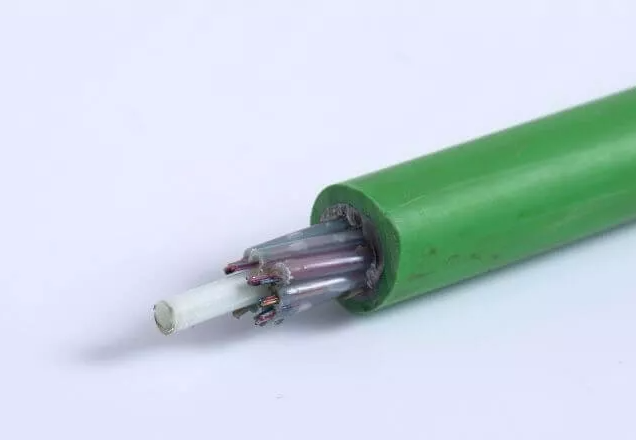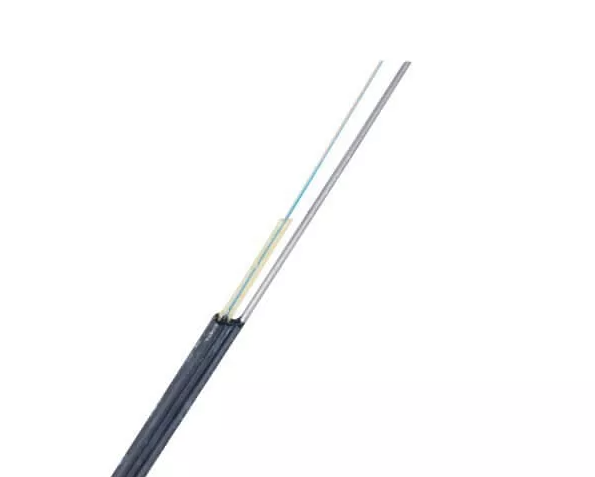TFcomposite‘s FRP fiber optic cable is a self supporting and bow type fiber drop cable with 2 parallel FRP strength member. FRP stands for fiberglass reinforced plastic material, it has the strength of steel wire but less weight, and the FRP is also corrosion resistant and durable. As result, this structure is ideal for fiber to the home drop cable.
Product performance introduction
FRP Fiber Optic Cable Features
Light Weight & Excellent Tensile Strength
Prevent Cable buckling
Most Suited for Multi-Loose Tube, Uni Tube, Slotted Core & Ribbon Cable Designs
Used as central or peripheral reinforcement in fibre optic cable
Dual Advantage : Reinforcement during installation as well as reduce stress on signal carrying optic fibre /conductor
Prevent sagging in aerial installation
Cost effective solution as a strength member

FRP Fiber Optic Cable Application
It is a di-electric composite cable strength member widely. It is designed to provide excellent tensile strength performance while maintaining high degree of stiffness, preventing cable buckling over its entire service life. It is most suited for loose tube, uni-tube, slotted core or ribbon cable, typically used as central or peripheral reinforcement in fiber optic cables. FRP Fiber Optic Cable serve a dual purpose. It provides cable reinforcement during installation, reduces tension on signal carrying optic fiber/ conductor. The lightweight FRP prevents the cable from sagging in aerial installations and its rigidity and strength takes on the load of cable.
Let’s compare FRP with Steel as a strength reinforcement in fiber optic cable:
| Parameter | FRP Composites | Steel |
| Corrosion, rot and and insect resistance |
Resists a broad range of chemicals and is unaffected by moisture or immersion in water. Resists insect damage. Painting is only suggested when exposed to UV rays/direct sunlight. |
Subject to oxidation and corrosion. Requires painting or galvanizing for many applications. |
| Strength | Has greater flexural strength and pound-for-pound is often stronger than steel and aluminum in the lengthwise direction. |
Homogeneous material |
| Weight | Weighs 75% less than steel and 30% less than aluminum |
Could require lifting equipment to move and place |
| Electrical conductivity | Nonconductive High dielectric capability |
Conducts electricity Grounding potential |
| Thermal properties | Good insulator with low thermal conductivity |
Conducts heat |
| Stiffness | Will not permanently deform under working load. Modulus of elasticity: 2.8 x 106 psi |
Modulus of elasticity: 29 x 106 psi |
| Impact resistance | Will not permanently deform under impact. Glass mat in pultruded parts distributes impact load to prevent surface damage, even in subzero temperatures. |
Can permanently deform under impact |
| Color | Color is molded within No painting required |
Must be painted for color, may require repainting over time |
| Cost | Lower installation costs, less maintenance and longer product life allow for a lower lifecycle cost. |
Lower initial material cost More expensive to maintain Much higher over time |
FRP Fiber Optic Cable
Series :
Proxy Products >application
Fiber to the home drop cable
Stranding :
the required number of elements (tubes or fillers)
Tube :
thermoplastic material, containing up to 12 optical fibers and filled with a suitable water-tightness compound
Core Wrapping :
water-blocking tape & yarns (dry core)
FAQ
Q :
Where does FRP Strength Members fit into Fiber Optic Drop Cable?
A :
FRP reinforcement is not the messenger, but in a common configuration will straddle the optical cable within the jacket. In the case of Multicom fiber optic cable, we have constructed our cable in such a way that the optical fiber has the absolute least exposure and the FRP strength members are in a position to guard the hair-thin optical cables to keep them out of harm’s way.
Other related products


